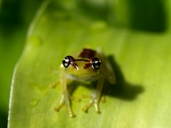|
Description
M 21-24 mm, F 35 mm. Tibiotarsal articulation reaches at least the nostril and often beyond snout tip. Hand with some webbing, foot webbing 1(0), 2i(0.5), 2e(0), 3i(0.5), 3e(0), 4i(1.5), 4e(1), 5(0.25). Dorsal skin smooth. Dorsally green, with a more or less complete dorsolateral yellow stripe that often fades at midbody. Usually a pattern of light green, red and brown dots and patches, especially the brown pigments can be very extended in some specimens although they are nearly completely absent in others. Outer iris area turquoise, iris periphery blue (Glaw and Vences 2007).
Distribution and Habitat
Country distribution from AmphibiaWeb's database: Madagascar
Ambahaka forest, Andasibe, Mandriandry forest, Ranomafana, Vinanitelo, Vohiparara (Glaw and Vences 2007). It has been recorded from 800-1,000 m asl (Vences and Glaw 2008). It is found within rainforest, both deeper within and closer to the forest edge (Vences and Glaw 2008).Life History, Abundance, Activity, and Special Behaviors
Habits are similar to those of Boophis rappiodes, in which calling males have been observed at night in the vegation 1-3m above the ground, usually along large and relatively slow-moving streams and small rivers near rainforest. For Boophis bottae, however, two very different call types have been observed. The first is a short, high-pitched note, very similar to that of B. rappiodes but usually consisting of three click pulses. The second call type is a rapid series of two-click notes which can go on for 2-3 seconds (Glaw and Vences 2007). Trends and Threats
It is found within two protected areas, the Parc National de Ranomafana and the Analamazoatra Special Reserve. Major threats include habitat loss due to increasing subsistence agriculture, logging, charcoal manufacture, invasion and spread of eucalyptus, increased grazing, and expanding human settlement (Vences and Glaw 2008). Possible reasons for amphibian decline General habitat alteration and loss
Habitat modification from deforestation, or logging related activities
Intensified agriculture or grazing
Subtle changes to necessary specialized habitat
Comments
Taken partly from Glaw and Vences (2007), with permission.
References
Glaw, F., and Vences, M. (2007). Field Guide to the Amphibians and Reptiles of Madagascar. Third Edition. Vences and Glaw Verlag, Köln.
Vences, M., and Glaw, F. (2008). Boophis bottae. In: IUCN 2008. 2008 IUCN Red List of Threatened Species. www.iucnredlist.org. Downloaded on 23 March 2009.
Originally submitted by: Miguel Vences and Frank Glaw (first posted 2009-03-17)
Edited by: Kellie Whittaker (2009-04-14)Species Account Citation: AmphibiaWeb 2009 Boophis bottae <https://amphibiaweb.org/species/6037> University of California, Berkeley, CA, USA. Accessed May 31, 2025.
Feedback or comments about this page.
Citation: AmphibiaWeb. 2025. <https://amphibiaweb.org> University of California, Berkeley, CA, USA. Accessed 31 May 2025.
AmphibiaWeb's policy on data use.
|
